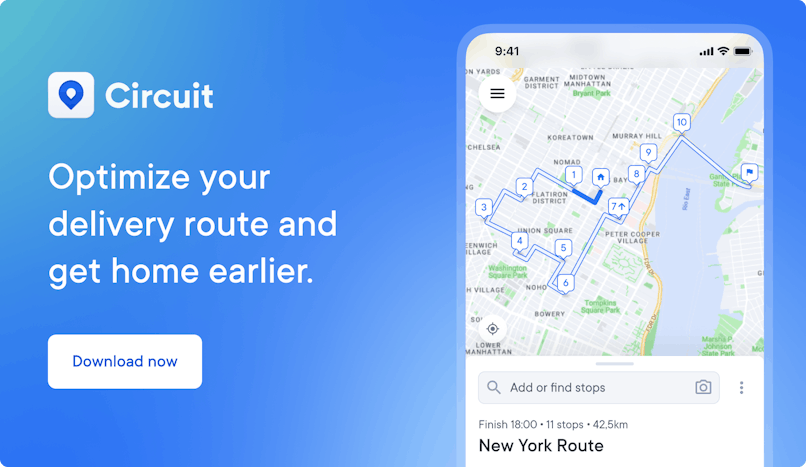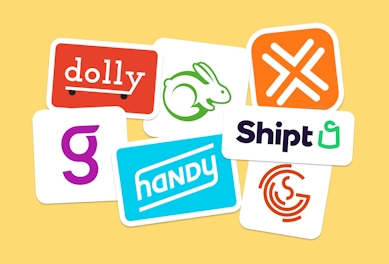Guide to Filing Tax Returns for Delivery Drivers in 2023
Delivery drivers are responsible for tax compliance. Learn how tax returns for independent delivery drivers differ from regular employees.

Filing taxes as a delivery driver can be a hassle. At least you can avoid delivery route headaches when you have Circuit Route Planner!
A rideshare or delivery driver gig can be a great way to earn some extra cash. But before you start spending your hard-earned money, remember that you’ve got to pay taxes on your earnings!
Failing to pay self-employment taxes can result in a potential audit from relevant tax authorities like the Internal Revenue Service (IRS). You could face charges, fines, and even jail time in the worst-case scenario.
Long story short: Trying to skip out on your taxes? Not worth it.
If you’re employed, your employer should withhold the necessary taxes (and other things like Medicare and Social Security contributions). But if you’re an independent contractor, it’s on you to make sure you’re setting aside money to pay your taxes when the time comes.
Ugh. Taxes = less money + more paperwork.
The last things you want to deal with.
We hate to be the bearer of bad news, but it’s a necessary evil.
Luckily, filing your taxes as a rideshare or delivery driver is easier than you might think. Plus, you can claim certain business expenses as tax deductions, which can help lower your taxable income so you don’t have to pay as much.
Today, we’re going to look at filing tax returns for delivery drivers, including everything from when you have to file to what kinds of deductions you can claim.

When are tax filings due?
Completing tax forms can take time, so you want to make sure you don’t leave this job for the last minute.
Even if you hire a bookkeeper or accountant to get the job done, they’ll need a heads-up if they’re going to get your paperwork finished by the deadline.
So, when are your taxes due? It depends on where you live. Here’s a quick overview:
- Tax filing deadline in the United States: The U.S. tax filing deadline is April 15 of the year following the relevant tax year. Your 2021 return is due by April 15, 2022. You can file a request for a deadline extension (IRS Form 4868, Application for Automatic Extension of Time to File U.S. Individual Income Tax Return) by April 15 if you need more time. That said, a late filing doesn’t guarantee late payment without penalty. You may have to pay late fees on any taxes not paid on time.
- Tax filing deadline in the United Kingdom: In the United Kingdom, the tax filing deadline for self-employed individuals to complete a self-assessment tax return is October 31 if you’re filing on paper. You can file electronically if you need more time, in which case the deadline is January 31 of the following year. That said, January 31 is also the due date for any taxes owed. Late payments can result in fines of up to 5% of your total tax bill. Payment delayed by 12 months or more can result in a fine matching 100% of your total tax bill.
- Tax filing deadline in Australia: Australia residents must file an individual tax return by October 31. You may apply for an extension if you can’t make this deadline, but you’ll have to go through a tax agent. Anyone earning more than the tax-free threshold of $18,200 AUD must file. You’ll then get an income tax assessment of what you owe from the Australian Taxation Office (ATO) and, if applicable, the Commission of Taxation.
Filing as an employee or an independent contractor

Most drivers working for delivery companies like Doordash, Uber Eats, Instacart, and Grubhub aren’t classified as employees but as independent contractors. The process and paperwork for filing taxes both vary between independent contractors and employees.
Wherever you’re located in the world, the first step when filing your taxes is to determine what type of tax filer you are — an employee or an independent contractor.
Employees generally receive a regular paycheck, often with taxes, Medicare, and Social Security contributions already withheld and subtracted from their gross pay. Independent contractors usually don’t receive this kind of corporate paycheck and must set aside a portion of their earnings to cover taxes.
Check with the relevant tax authorities if you aren’t sure of your worker class. Learn more about the distinction in the United States, the United Kingdom, and Australia.
It’s best to consult a tax professional if you still aren’t sure. Completing the wrong paperwork is a big headache and a waste of your time. An expert can make sure you’re starting on the right foot.
Who has to make quarterly tax payments?
When most people think about tax filing, they assume this is something they only have to do once a year. In fact, you may have to make quarterly tax payments in some cases.
If you’re a 1099 contractor in the U.S., for example, you have to track and pay state and federal income taxes, plus FICA withholdings, on your own. This applies if driving is your primary source of income and you expect to owe more than $1,000 in taxes.
In this case, you’ll have to calculate taxes owed and make an estimated tax prepayment every quarter.
In the U.S., these quarterly payments are usually due on April 15, June 15, September 15, and January 15 of the following tax year. The due date is the next business day if those dates fall on a holiday or weekend.
If you drive as a side hustle and are a W-4 employee at another job, you can have your withholdings changed to cover your rideshare income as well.
What can I claim on my taxes as a delivery driver?

You probably have to cover work-related expenses like gas and car maintenance if you’re a delivery driver. You might be able to claim these costs as tax deductions in some cases.
This means that the money you pay for those actual expenses is subtracted from your taxable income. Your taxable income is reduced, which means you can pay less in taxes.
Just what can you claim? Several possible tax write-offs will relate to your No. 1 business tool: your delivery vehicle.
Business mileage (the miles driven for business rather than personal use) is one major point to consider. The relevant tax authorities should have a standard mileage rate (for example, the IRS calculates 56 cents per business mile for the 2021 tax year).
Note that you can’t deduct both mileage and gas. You can deduct actual vehicle expenses as an alternative. This can include gas, maintenance, car payments, depreciation, and license and registration.
In addition to a mileage deduction, you can also include road tolls and parking expenses related to the business use of your vehicle. You can also claim roadside assistance or a vehicle inspection if used for business purposes.
Cellphone expenses are another big deduction that delivery drivers should look into during their tax preparation. If you have a phone, you can claim part of the phone bill according to the phone’s percentage of business use. If you use the phone for private life half the time and business life half the time, that’s 50% of the bill.
You can also claim mobile accessories like your phone charger. Other accessories you use for your delivery job may also be tax write-off eligible. For example, you probably use hot bags if you’re a food delivery driver. If you’re a courier, you may use a backpack.
Finally, if your delivery service employer requires you to get a background check (and you have to pay for it), it is an eligible deduction.
Ask a tax advice pro who specializes in helping small business owners if you’re unsure whether something counts as a tax expense. It’s better to get it right than risk an audit when filing your own taxes.
How Circuit Route Planner can save you time and money
Filing taxes as a rideshare or delivery driver can be a hassle. The good news? This is a task you don’t have to deal with every day.
Still, all that paperwork can be a headache when tax time rolls around at the end of the year. You don’t want to add stress about your delivery routes on top of it.
Luckily, there’s technology available to help make your day-to-day work easier. Circuit Route Planner is one must-have tool for any delivery driver, whether you’re working for Amazon Flex, Lyft, Postmates, or a different delivery app.
Circuit maps out your routes, giving you the fastest path from point A to point B. This helps you finish your delivery day faster — and gets you to the couch with a cold beer in hand sooner.
With the Circuit app on your mobile phone, you’ll also get other perks like a proof-of-delivery feature, the ability to leave delivery notes, and a Fast Package Finder.
Plus, since Circuit Route Planner is a work tool, you’ll probably claim it as a tax deduction.




